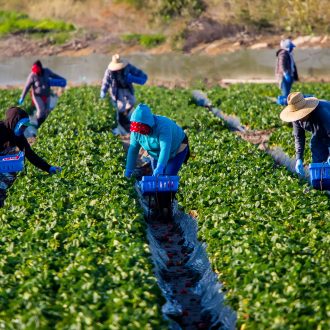The food that overflows our market shelves and fills our tables is harvested by men, women, and children who often cannot satisfy their own hunger
– Cesar Chavez
Below-Poverty Wages, Malnution and Hunger
- Farm workers in the United States earn an average of $10,000 per year.
- Farm worker wages have declined by more than 20% in the last twenty years, after accounting for inflation.
- Farm workers have the lowest annual family incomes of any U.S. wage and salary workers. (Charles D. Thompson Jr. and Melinda F. Wiggins, The Human Cost of Food: Farmworkers’ Lives, Labor and Advocacy. University of Texas Press; Austin; 2002.)
- Two-thirds of our nation’s migrant households, and seventy percent of our nation’s migrant children, live below the federal poverty line. (Daniel Rothenberg, With These Hands: The Hidden World of Migrant Farm workers Today. Harcourt Brace and Company. New York, San Diego, London. 1998.)
- A 2003 Study by researchers at Wake Forest University Baptist Medical Center found that nearly half of Latino migrant farm workes in central North Carolina couldn’t afford enough food for their families.
- One-half of all farm workers are hired through crew leaders or farm labor contractors. This arrangement allows growers to avoid their obligations under state or federal employment law – including minimum wage requirements. (Farmworker Justice Fund 2004 Report)
- Many farm workers are paid by the amount of the crop they harvest – by “piece rate.” For example, cucumber pickers in North Carolina receive approximately 65 cents for each 33 pound bucket they harvest. This averages out to around $3.90 per hour. (“Boycott Mt. Olive Pickles” circular. Farm Labor Organizing Committee, AFL-CIO. Toledo, Ohio.)
- Foreign-born farm workers are considerably more likely to be impoverished than those born in the United States; 65% vs. 42%. In 1997-1998, eighty-one percent of all farm workers in the U.S. were foreign-born; with the vast majority being from Mexico. (Mehta, et. al. “Findings From the National Agricultural Workers Survey (NAWS) 1997-1998: A Demographic And Employment Profile Of United States Farm workers.” U.S. Department of Labor, March 2000) (Note: Seventy-seven percent of all farm workers in the United States were born in Mexico. U.S.-born whites represent 7% of the farm labor workforce; while U.S.-born Latinos represent 9% and U.S.-born African Americans represent 1%. The average age of a farm worker is thirty-one. And eighty percent of all farm workers in the United States are men.) (Ibid.)
- In the state of Florida, many tomato pickers have not had a pay raise in over 20 years. They still earn between 40-50 cents for each 32-pound bucket they pick. (Coalition of Immokalee Workers (CIW). Immokalee, Florida.)
- In the state of California, thousands of agricultural employers routinely violate federal and state labor laws by underpaying, sometimes entirely stiffing, tens of thousands of farm workers, according to the Sacramento Bee. They reported that thirty-five percent of vineyard employers did not pay their workers the minimum wage. None of these employers were prosecuted for minimum wage violations. (Andy Furillo: “Toiling Under Abuse: Farm workers’ Struggle Goes On. A Sacramento Bee Special Report.” Sacramento Bee, May 20, 2001.)



